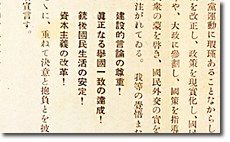HOME > Crisis in Constitutional Politics > c. Dissolution of Political Parties and Emergence of Yokusan (Imperial Rule Assistance) System > Transformation of the Proletarian Political Parties
4-9 Transformation of the Proletarian Political Parties

Great jubilation at the headquarters of the Socialist Masses (Popular) Party, which won a landslide in the February 20, 1936 (Showa 11) general election (front row, R to L, ASANUMA Inejiro, KONO Mitsu, ABE Iso'o, ASO Hisashi) From "Kokusai Shashin Joho. Vol.15 No.4"
The Zenkoku Rono Taishuto (National Labor/Farmer Masses Party) and Shakai Minshuto (Social Masses Party) were proletarian political parties that raised the flag of anti-fascism. The Manchurian Incident of September 1931 (Showa 6) was a turning point, when, both parties internally saw the rapid emergence of national socialist factions. To avert a crisis, the two parties merged in July 1932 (Showa 7), giving birth to Japan's only officially authorized proletarian political party as the Shakai Taishuto (Social Masses Party). Among the Party leaders were those who had great expectations of the young officers to topple capitalism and resolutely carry out domestic reform. Consequently, the power within the Party gradually tilted toward National Socialism.
In the general election of December 1936 (Showa 11), the public pinned great hopes on the anti-fascists, still the Shakai Taishuto increased its representation in the House of Representatives, to 37 seats. The Party leaders, having built up self-confidence through their successful electoral performance, instead drew closer to the military.
What solidified that trend was the outbreak of the Sino-Japanese War in July 1937 (Showa 12), sparked by the Marco Polo Bridge Incident on July 7 (Japanese troops of the Kwangtung Army, camped on one side of the bridge, claimed a soldier of theirs was missing in nearby Wanping Town, and demanded that the Kuomintang troops there let them look, giving them an ultimatum; when the KMT refused, the Japanese bombarded the town at midnight, and set in motion the events that led to Japan overrunning Peiping on July 29 and Tientsin, now Tianjin, on July 30, starting the 2nd Sino-Japanese War). The Shakai Taishuto avidly supported the war with China. At the Party convention held that November, the Party platform was revised so as to advocate the progress and development of the Japanese people based on the basic principle of the national polity. The Shakai Taishuto thus publicly declared its participation in the national unity framework.
Declaration, 6th Convention of the Shakai Taishuto
- 15 November 1937 (Showa 12)
- Papers of HAYASHI Torao, #10-108
- National Diet Library
- From "File of Documents from Shakai Taishuto, 1937 (Showa 12)"
